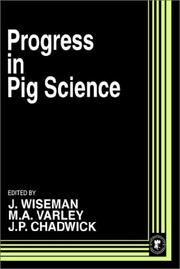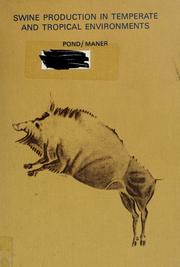| Listing 1 - 10 of 142 | << page >> |
Sort by
|
Dissertation
Abstract | Keywords | Export | Availability | Bookmark
 Loading...
Loading...Choose an application
- Reference Manager
- EndNote
- RefWorks (Direct export to RefWorks)
Cochlea --- Guinea Pigs --- pathology
Book
ISBN: 0851988563 Year: 1993 Publisher: Wallingford CAB international
Abstract | Keywords | Export | Availability | Bookmark
 Loading...
Loading...Choose an application
- Reference Manager
- EndNote
- RefWorks (Direct export to RefWorks)
636.4 --- Pigs. Swine --- Zoology and Animal Sciences. Farm and Captive Animals --- Pigs --- Pigs. --- 636.4 Pigs. Swine
Book
Abstract | Keywords | Export | Availability | Bookmark
 Loading...
Loading...Choose an application
- Reference Manager
- EndNote
- RefWorks (Direct export to RefWorks)
Guinea Pigs --- Histology --- anatomy & histology

ISBN: 1897676263 Year: 1998 Publisher: Nottingham Nottingham university press
Abstract | Keywords | Export | Availability | Bookmark
 Loading...
Loading...Choose an application
- Reference Manager
- EndNote
- RefWorks (Direct export to RefWorks)
Zoology and Animal Sciences. Farm and Captive Animals --- Pigs. --- 636.4 --- 636.4 Pigs. Swine --- Pigs. Swine
Book
ISBN: 1897676220 Year: 1994 Publisher: Nottingham Nottingham university press
Abstract | Keywords | Export | Availability | Bookmark
 Loading...
Loading...Choose an application
- Reference Manager
- EndNote
- RefWorks (Direct export to RefWorks)
636.4 --- 637.5'64 --- Pigs. Swine --- Pork --- Zoology and Animal Sciences. Farm and Captive Animals --- Pigs --- Pigs. --- 637.5'64 Pork --- 636.4 Pigs. Swine
Book
ISBN: 0429105738 1138473642 1439835586 143983556X 1322613044 1000218759 Year: 2018 Publisher: Boca Raton, FL : CRC Press,
Abstract | Keywords | Export | Availability | Bookmark
 Loading...
Loading...Choose an application
- Reference Manager
- EndNote
- RefWorks (Direct export to RefWorks)
Praise for the First Edition.
Book
Year: 2020 Publisher: Basel, Switzerland : MDPI - Multidisciplinary Digital Publishing Institute,
Abstract | Keywords | Export | Availability | Bookmark
 Loading...
Loading...Choose an application
- Reference Manager
- EndNote
- RefWorks (Direct export to RefWorks)
Pigs have a strong motivation to explore and root. In conventional pig husbandry systems, this need is difficult to fulfil, unless adequate enrichment materials are provided. This book summarises how enrichment strategies for pigs have evolved over the last few decades in different countries and provides a vast array of possibilities to enhance the exploratory needs of pigs. The role of enrichment material on avoidance of tail biting outbreaks or as an element triggering positive emotions in pigs is also discussed.
Pigs. --- Life sciences. --- Biology --- Study and teaching.
Book
ISBN: 0851983537 Year: 1975 Publisher: Slough Commonwealth agricultural bureaux
Abstract | Keywords | Export | Availability | Bookmark
 Loading...
Loading...Choose an application
- Reference Manager
- EndNote
- RefWorks (Direct export to RefWorks)
636.4 --- 619 --- 616.6 --- 618 --- Pigs. Swine --- 636.4 Pigs. Swine

ISBN: 071670840X 9780716708407 Year: 1974 Publisher: San Francisco Freeman
Abstract | Keywords | Export | Availability | Bookmark
 Loading...
Loading...Choose an application
- Reference Manager
- EndNote
- RefWorks (Direct export to RefWorks)
Swine --- 636.4 --- 636.4 Pigs. Swine --- Pigs. Swine --- Domestic pig --- Hogs --- Pig --- Pig farming --- Pigs --- Sus domestica --- Sus domesticus --- Sus scrofa domestica --- Sus scrofa domesticus --- Livestock --- Sus
Dissertation
ISBN: 9789088263385 Year: 2013 Volume: 1153 Publisher: Leuven : Katholieke Universiteit Leuven. Faculty Bioscience Engineering,
Abstract | Keywords | Export | Availability | Bookmark
 Loading...
Loading...Choose an application
- Reference Manager
- EndNote
- RefWorks (Direct export to RefWorks)
Variousapproaches have been tried to reduce or even eliminate the occurrence of ETECinfections in piglets. The therapeutic use of antibiotics has been, by far, themost common practice to control this problem.Next to thetherapeutic use of antibiotics, they were applied as antibacterial growthpromoters (AGP). AGPs were and are relatively cheap and cost-effective, hence theirpopularity. Due to public concern on the increase of antibiotic resistantbacteria, the use of antibiotics as AGPs has been banned. Many alternatives toreplace AGPs have been proposed but proved to be ineffective.Recently, a newapproach has been suggested to combat ETEC infection by inhibiting theadherence of the toxin to its receptor in the small intestine. While thisapproach is verypromising, problems arise due to regulatory and registrationissues and costs of manufacturing and designing artificial components.In this researchwe used a similar approach but tried to eliminate the above problems by usingnatural components. Recently, research groups have demonstrated that they wereable to inhibit the activity of several toxins of the AB5 family, like shiga-and cholera toxin by using polyphenols. Since LT isclosely related to these toxins, our first research question was: is thisinhibition of several AB5 toxins an effect shared by all its members, and thuscan polyphenols be used in vitro toinhibit the effects of LT toxins.With this aim wetested several components that have been suggested to possess variousanti-binding effects. Our results demonstrated that only D-(+)-galactose,lactose and N-acetyl-D-galactosamine and two tea extracts, which have a veryhigh polyphenol concentration, were able to inhibit the binding of LT to itsGM1 receptor. In the cyclic adenosine monophosphate (cAMP) assay, only the twotea extracts showed inhibitory activity. This shows that D-(+)-galactose, lactoseand N-acetyl-D-galactosamine can indeed inhibit LT binding to GM1 based onstructural homology with GM1 in the abse nce of living cells. However, in thecAMP assay, D-(+)-galactose, lactose and N-acetyl-D-galactosamine areapparently metabolized to below their effective inhibitory concentration,indicating limited practical applicability invivo and high costs due to their high effective concentration. Both teaextracts maintained their activity in the presence of cells.Secondly, wewanted to dig deeper on how these polyphenols exert their anti-binding effects.Here, seven different polyphenols were tested in vitro (1) for inhibition of LT binding to GM1 (GM1-ELISA), (2)for LT inhibitory activity in the cAMP Vero-cell assay, and (3) for testingtheir aggregating properties with LT using molecular weight exclusion membranefilters, and centrifugation techniques. Our results showed only three out ofseven polyphenols, i.e. pentagalloylglucose (PGG), epigallocatechin gallate(EGCG) and gallocatechin gallate (GCG), to be active with all three techniquesused. It was concluded that direct inhibition of LT-induced cAMP, and blockingof the GM1 receptor is unlikely to be the underlying mechanism. Surprisinglythe inhibitory activities of polyphenols coincided with the formation of largeLT-polyphenol aggregates (>100 kDa) Furthermore it became clear that theenterotoxin inactivation property of polyphenols depends on the number ofgalloyl moieties in the polyphenol structure.Finally, aftershedding some light on the mechanism, a final part of this thesis was dedicatedto evaluation of effectiveness in vivo.Severalcommercial polyphenol extracts were tested in an invivo post-weaning diarrhoea (PWD) model in piglets, two extractswith (OMNIVIN, and ALSOK), and one without (OMNICOA)in vitro activity were tested for in vivo efficacy. Piglets were divided in four treatment groupsreceiving various polyphenols; half of each treatment group was infected withETEC on day 6 and 7. Post-infection, rectal faeces were assessed daily fordiarrhoea (as % DM), ETEC excretion, and average daily gain (ADG). Averagedaily feed intake (ADFI), feed conversion ratio (FCR) were determined forgrowth performance. Post-infection, ETEC excretion (day 6-13) was reducedsignificantly by addition of all three extracts compared to the control group.While diarrhoea increased significantly following infection of the controlgroup, this increase was lifted in the OMNIVIN and ALSOK group, but not in theOMNICOA group. Differences between treatments were absent for ADG, ADFI and FCRpre- and post-infection, except for OMNICOA, which significantly depressed ADGpost-infection. The latter result suggests OMNICOA to contain one or moreanti-nutritional factors. The overall results for the different polyphenolextracts were consistent with the respective in vitro activities in the LT-inhibition assay. It was concludedthat polyphenol extracts widely differ in properties, some may have deleteriouseffects, but others can indeed reduce ETEC-induced diarrhoea most likely byinactivating LT in vivo. By doingthis we were able to demonstrate that some, but not all, commercial polyphenolextracts were able to control ETEC infection in early-weaned piglets.In conclusion, we haveprovided the first evidence that polyphenols are indeed a commercial viablefeed supplement in the prevention of ETEC diarrhoea. Further in vivo research is needed to confirmthe first results as well as to make a cost/benefit analysis for potentialcommercial use.
academic collection --- 636.4 --- 579.842.11 --- Pigs. Swine --- Escherichia --- Theses --- 579.842.11 Escherichia --- 636.4 Pigs. Swine
| Listing 1 - 10 of 142 | << page >> |
Sort by
|

 Search
Search Feedback
Feedback About
About Help
Help News
News